» The mid-year climate change conference will take place from June 3 to June 13, 2024, in Bonn, Germany.
» The 29th Conference of the Parties to the U.N. Framework Convention on Climate Change (UNFCCC COP 29) will be held in Baku, Azerbaijan, from November 11 to November 22, 2024.
This year, at UNFCCC COP 29 in Baku, Azerbaijan, representatives from nearly 200 countries will seek to fulfill ambitious climate financing goals and accelerate national action on climate change to achieve the goals of the Paris Agreement. Leading up to COP 29, the mid-year climate conference (SB 60) in Bonn, Germany is an important opportunity to build momentum with international stakeholders and negotiators.
Conservation International’s policy position paper for the mid-year climate conference in Bonn (SB 60) is available here in English, French, Spanish, and Bahasa Indonesia; please see below for an overview of our policy priorities.
PRESS CONTACT
Jessica Brown, Senior Director of Media Relations
See our latest news and press releases at conservation.org/newsroom.
Nature In the 2025 NDCs: What Do We Need to See?
- Time/Date: Wednesday, June 12, 11:45-13:00 (CEST)
- Location: Bonn meeting room, World Conference Center Bonn (Plenary Building)
The 2023 Global Stocktake, which evaluated progress on climate action, clearly emphasized the importance of nature and ecosystems in achieving the Paris Agreement goals. This session will critically assess the uptake of nature in climate policy and action to date and examine how ambition can be further raised in countries' Nationally Determined Contributions (NDCs), which are due next year. The session will bring together senior experts and policymakers from the International Union for Conservation of Nature (IUCN) and other partners working on this issue.
For more details on the events, please contact Shira Lyss-Loren.
U.N. Framework Convention on Climate Change mid-year conference (SB 60)
Learn more about this session on the UNFCCC website »
U.N. Framework Convention on Climate Change COP 29 – Baku
Learn more about this session on the UNFCCC website »
The Conference of the Parties (COP) refers to the annual meeting of the 197 parties of the 1992 United Nations Framework Convention on Climate Change (UNFCCC). This year’s annual meeting in Baku, Azerbaijan, is the 29th annual COP to advance the shared objective of tackling climate change.
Mid-Year Climate Change Conference in Bonn
At the mid-year climate conference in Bonn, Conservation International will engage with key decision makers and global stakeholders to advance discussions and implement commitments made in previous climate conferences — and help set the groundwork for COP 29 to accelerate climate action by governments and the private sector.
Conservation International’s engagement focuses on elevating the role of nature-based solutions to climate change — such as protecting forests, mangroves and peatlands — to both limit global warming and help communities adapt to climate change. During formal negotiations in Bonn, Conservation International will advise countries on the need to accelerate support and incentives for nature-based solutions for climate action. The critical role of nature should be reflected in all negotiation topics under the Paris Agreement, especially on climate ambition, adaptation and the mobilization of transformational finance. This includes international cooperation mechanisms such as Article 6, which outlines how countries can work together on the vital task of reducing carbon emissions.
The conference in Bonn will also set the stage for critical discussions on addressing climate impacts, just transition pathways and accountability. Conservation International coordinates with partners representing diverse sectors to galvanize action on these issues — both in and outside of the negotiation rooms. Continuing these conversations throughout the year is imperative to achieving success at COP 29.
Natural climate solutions, which are essential to the Paris Agreement’s goals, provide opportunities for countries to increase their climate ambition; they must be part of countries’ NDCs and complementary Paris Agreement mechanisms. Harnessing the full potential of nature to mitigate climate change — and help communities adapt to its impacts — is critical to the success of the Paris Agreement.
Our approach
Conserving nature is critical to achieving the Paris Agreement’s goals. Protecting, sustainably managing and restoring natural ecosystems, such as forests and wetlands, can provide at least 30 percent of the global action needed to limit average temperature rise to 1.5 degrees Celsius (2.7 degrees Fahrenheit). Yet, nature conservation currently receives only 3 percent of global climate finance. The financing gap for climate mitigation needed in the agriculture, forestry and other land use sectors is larger than the financing gap to mitigate climate change in other sectors (energy, transport, and industry) — and does not account for the billions of dollars that continue to flow into practices that destroy nature and drive greenhouse gas emissions. Estimates show nature-related climate action requires between about US$ 100-300 billion a year in funding — about 10 to 30 times what’s currently available — to meet the Paris Agreement’s targets.
Nature remains among the most effective — and cost-effective — climate solutions. U.N. research shows that three actions — reducing the destruction of forests and other ecosystems, restoring ecosystems and improving the management of working lands, such as farms — are among the top five most effective strategies for cutting climate-warming carbon. Protecting and restoring nature is also necessary to achieve most of the U.N.’s Sustainable Development Goals, which were established in 2015 to end poverty, protect the planet and improve the lives of people everywhere.
Increasing actions that protect and conserve nature to address the climate, biodiversity and ocean crises is key. Nature conservation can directly and materially improve the lives of billions of people around the world. As stewards of lands that contain almost a quarter of the world’s land-based carbon, Indigenous peoples and local communities are on the front lines of climate change. To recognize the importance of these stakeholders, Conservation International works to connect Indigenous peoples and local communities to funding, training and technology — helping to secure their land rights so that protecting nature also protects their livelihoods.
Conservation International helps countries achieve the goals of the Paris Agreement by providing policy recommendations, scientific models, tools and funding platforms for implementing natural climate solutions at scale. We envision a world where nature’s contribution to addressing climate change is maximized — meaning natural climate solutions are implemented to their fullest potential for mitigating climate change — and are also fully deployed in places where ecosystems can help vulnerable populations adapt to the already-present and future effects of climate change.
This is an important time for countries to accelerate the implementation of their Nationally Determined Contributions — their targets for achieving the Paris Agreement — and for the international community to provide additional technical and financial support.
While some countries have taken positive steps towards increasing their ambition to address climate change and provide implementation support, more ambition, more action, and more finance are needed to prevent the most dangerous impacts of climate change and ensure communities can adapt to its impacts.
Our Policy Objectives for the 2024 Mid-Year Climate Negotiations
Conservation International works to equip decision makers with accessible, policy-relevant science to restore and protect critical ecosystems as part of global climate action.
At the UNFCCC mid-year climate conference in Bonn, Conservation International will strive to advance the role of nature in implementing the Paris Agreement by calling on countries to:
Increase efficiency of delivering climate goals and finance through cooperative mechanisms.
- Focus on major outstanding issues for the operationalization of Article 6 and ensure the work program on emissions avoidance (under Articles 6.2 and 6.4) and on conservation enhancement (under Article 6.4) maintains a narrow scope in line with its mandate and does not undermine the role of nature-based solutions.
- To incentivize ambitious mitigation action, all approaches under Article 6 should accelerate nature-based solutions with rigorous environmental and social integrity and broad inclusion of countries and stakeholders. For this purpose, Parties should encourage nature-based emission reductions and removals and avoid imposing any requirements that could inappropriately discourage their use under the Article 6.4 mechanism.
- Engage Indigenous peoples and local communities in discussions on the linkages between Article 6 operationalization and the Local Communities and Indigenous Peoples Platform.
Ensure the New Collective Quantified Goal on climate finance (NCQG) sets ambitious goals that incorporate finance needs for nature-based solutions.
- Adopt a multi-layer approach, in line with the Kunming–Montreal Global Biodiversity Framework, consisting of quantitative targets for the mobilization or provision of climate finance and phasing out harmful subsidies, and qualitative elements for domestic resource mobilization, leveraging private finance, and promoting use of blended finance and innovative instruments.
- Consider setting indicative sub-goals related to each sector and/or mitigation pathway. For example, countries should aim to allocate 30percent of their finance to nature-based solutions, as it must contribute 30 percent of mitigation action to meet the 1.5°C goal.
- Develop qualitative goals as indicators for successful NCQG delivery, such as standards for high quality, enhanced direct access, balanced delivery, cost-effectiveness, maximization of social and ecological benefits, reduced debt stress, and addressing knowledge and capacity gaps.
Integrate nature and climate vulnerable people into the metrics and indicators for Global Goal on Adaptation (GGA) framework.
- Target 9d of the GGA should aim to effectively conserve and manage 30% of terrestrial, inland water, mountain, marine and coastal ecosystems to support climate adaptation. This target should give special attention to ecosystems most vulnerable to climate change (e.g. mountains, coastal areas, dry areas, wetlands) and those crucial for providing adaptation benefits to both people and species that depend on them.
- Nature-based solutions for adaptation should be explicitly incorporated into all other thematic and dimensional targets and indicators of the GGA, as they can provide relevant adaptation benefits for such targets.
- Robust metrics, indicators, and potential quantified elements of targets for the GGA Framework must consider the traditional ecological knowledge of Indigenous Peoples and Local Communities in addition toscientific knowledge and should incorporate locally led ecosystem-based adaptation approaches.
Strengthen the functions of the Local Communities and Indigenous Peoples Platform (LCIPP) to ensure inclusive and effective participation in climate policy processes and benefit-sharing.
- Consistently apply the LCIPP side-by-side collaborative model between Parties and Indigenous peoples and implement LCIPP recommendations on the engagement and input of Indigenous peoples and local communities across UNFCCC processes.
- Ensure the full operationalization of LCIPP functions through the implementation of the second three-year workplan and promote spaces for its representatives to participate and contribute to relevant negotiation agenda items, including the Article 6.8 work programme, the Global Goal on Adaptation, and Loss and Damage.
- Increase meaningful engagement of governments in the LCIPP activities, especially in those aimed at improving the participation of Indigenous peoples and local communities in national climate policy planning and financing.
Continue building and enhancing urgent action on the ocean–climate nexus.
- Increase and mobilize finance flows for coastal nature-based solutions within negotiations and processes related to climate finance, including the NCQG and 2024 Standing Committee on Finance Forum.
- Incorporate indicators for coastal nature-based solutions within the indicators of the Global Goal on Adaptation.
- Build capacity and understanding of the ways in which coastal nature-based solutions, including the conservation and restoration of blue carbon habitats, can be included in new and updated NDCs and National Adaptation Plans.
- During the Global Stocktake (GST) Dialogue, share best practices and feedback on how to use the GST outcome to inform the next NDCs, including ways in which countries can utilize coastal nature-based solutions for mitigation and adaptation actions.
Increase support for the role of nature-based solutions and effective incentives for nature-positive economies in achieving just transition pathways.
- The role of nature-based solutions and nature jobs in achieving just transition pathways, including the economic incentives needed to equitably develop them, should be the focus of at least one dialogue and/or roundtable discussion, as well as incorporated in a cross-cutting manner throughout the UAE Just Transition work programme.
- Develop practical guidance on accelerating nature-positive just transition pathways for adoption within NDCs and across the Paris Agreement mechanisms, especially to prevent and reduce the impacts of climate change on the most vulnerable, including in rural areas, increasing their resilience, and improving livelihoods.
Publications

SB 60 Policy Recommendations (English)

SB 60 Policy Recommendations (Spanish)

SB 60 Policy Recommendations (French)

SB 60 Policy Recommendations (Bahasa Indonesia)
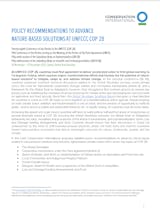
Policy Recommendations to Advance Nature-Based Solutions at UNFCCC COP 28
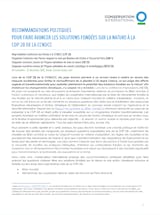
Policy Recommendations to Advance Nature-Based Solutions at UNFCCC COP 28 (French)
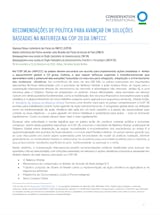
Policy Recommendations to Advance Nature-Based Solutions at UNFCCC COP 28 (Portuguese)
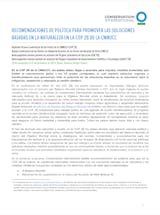
Policy Recommendations to Advance Nature-Based Solutions at UNFCCC COP 28 (Spanish)
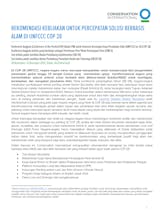
Policy Recommendations to Advance Nature-Based Solutions at UNFCCC COP 28 (Indonesian)
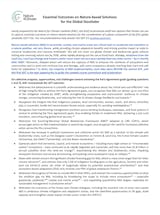
Essential Outcomes on Nature-based Solutions for the Global Stocktake

Technical Note: Understanding Risk of Reversals in Nature Based Removals
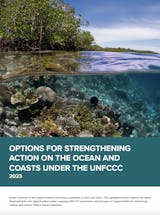
UNFCCC Ocean Climate Options 2023
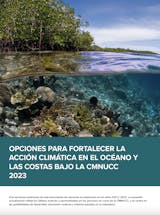
OPCIONES PARA FORTALECER LA ACCIÓN CLIMÁTICA EN EL OCÉANO Y LAS COSTAS BAJO LA CMNUCC 2023

OPTIONS POUR LE RENFORCEMENT DES ACTIONS SUR LES OCÉANS ET LES ZONES CÔTIÈRES DANS LE CADRE DE LA CCNUCC 2023




